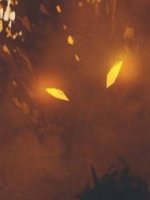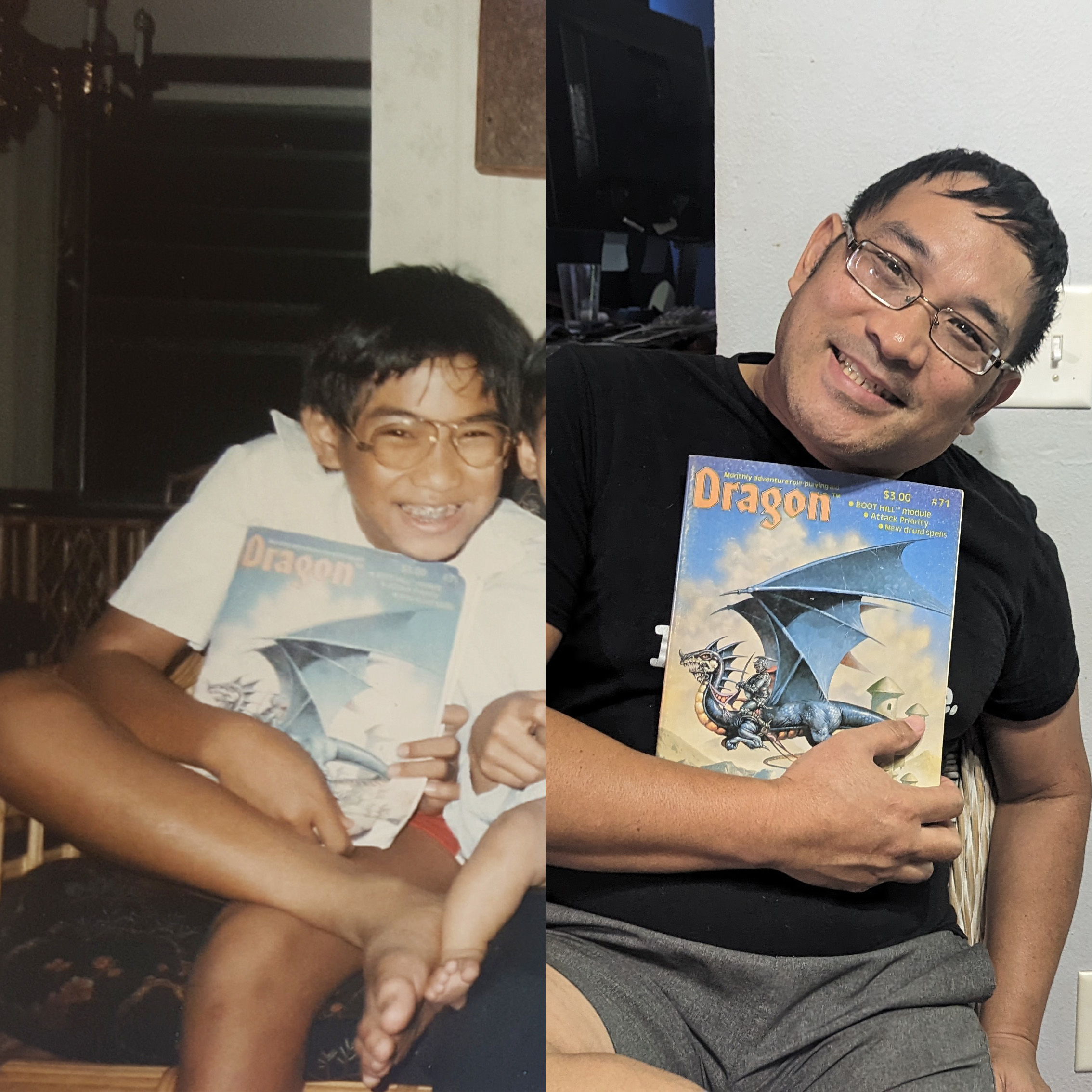Dragon Publishing released Dragon #71 in March 1983. It is 84 pages long and has a cover price of $3.00. In this issue, we have intelligent monsters, quasi-deities, and a new Boot Hill adventure!

This month's Special Attraction is "The Taming of Brimstone," a Boot Hill scenario about a wild west town that has fallen into chaos and lawlessness after the discovery of silver in nearby mountains. The player characters are "town tamers," tough gunslingers tasked with restoring law and order. Brimstone is presented as a mini-sandbox, with various locations, NPCs, and special events all nicely detailed. The author was Donald Mumma, who appears to have published nothing else.
"In the Blink of a Wizard's Eye" by Joel Rosenberg tells the story of two powerful wizards meeting in a dark tavern. They lament various challenges, such as aging, mortality, boredom, and conflict, until one proposes an unusual solution to their problems. Rosenberg previously published "WearWolf" in Dragon #60.
In "The Mind of the Monster," Bruce Humphrey encourages DMs to infuse monsters with unique personalities, introducing a layer of unpredictability to add depth. He argues that monster intelligence is critical, as it influences a creature's decision-making, recognition of magic, and interaction with the players. The author states that keeping this in mind will increase player satisfaction as they defeat worthy foes rather than "paper golems." There are some strong ideas here, though it is a little wordy.
In "Greyhawk's World," Gary Gygax introduces the concept of quasi-deities, powerful beings that reside between the status of significant characters and demigods. Among these quasi-deities are Heward, Keoghtom, and Murlynd, who he first introduced to the public in X2: The Land Beyond The Magic Mirror. All these characters were associated with childhood friends of Gygax: Murlynd was Don Kaye's D&D character, Keoghtom is an anagram of Tom Keogh, and he derived Heward from the name of his cousin, Hugh Burdick.
"Who gets the first swing?" by Ronald Hall discusses the limitations of the AD&D combat system and suggests an alternative approach he calls the Attack Priority System, aiming for a more dynamic combat experience. The proposal considers factors like weapon speed, length, strength, dexterity, and experience to determine the order of attacks. It also suggests modifiers for strategies such as retreats, presses, and fending. Hall claims the system gives more realism without more work, but it looks complex to me.
On to the regular offerings! In "From the Sorceror's Scroll," Gygax presents 15 new druid spells, including now-classics such as cloudburst, goodberry, and spike growth. He says he did not create more because Len Lakofka has created many new druid spells that will likely become official.
Roger E. Moore hosts this month's edition of "Sage Advice," answering questions about his Astral Plane article in Dragon #67. Queries include "Does the Astral Plane contact the Elemental Plane?" and "How does one drink potions in a weightless condition?"
Gygax returns with more "Deities and Demigods of the World of Greyhawk," this time presenting stats and background for Erythnul the Many, Incabulos, Nerul the Reaper, Ralishaz the Unlooked For, and Wastri the Hopping Prophet. They are all nicely detailed, especially Wastri.
There are two game reviews. Swordbearer, a fantasy RPG published by Heritage USA, boasts a clever and logical design. It has a distinct magic system, a deep character generation method, and commendable advice for game masters. Reviewer Ken Rolston asserts it "...is a quality product—a complete FRP system with many original and intelligent ideas. If it receives adequate product support, it may rise up through the ranks of aspiring competitors and join the big boys of FRP." History tells us that the game never did join the "big boys."
DUNZHIN by Med Systems Software represents a significant advancement in fantasy computer gaming. Shifting away from the static approach of previous games, DUNZHIN generates a new dungeon for each adventure. The game successfully captures many elements of tabletop RPGs, although it does have limitations, such as only offering the fighter class. Reviewer John Warren says it "...goes a long way toward accurately translating the fantasy role-playing experience into computer gaming." The game also received many positive reviews in the contemporary computer press.
This month's cover was by Clyde Caldwell. Interior artists include Phil Foglio, Steve Chappell, Brian Born, Harry Quinn, Edward Atwood, Roger Raupp, E. B. Wagner, Jeff Easley, and Dave Trampier.
And that's a wrap! I enjoyed this issue, though there were no real stand-out articles. If pressed for a favorite, I'd nominate "Greyhawk's World." Next issue, we have gems galore, a new Tom Wham game, and cavaliers!
This month's Special Attraction is "The Taming of Brimstone," a Boot Hill scenario about a wild west town that has fallen into chaos and lawlessness after the discovery of silver in nearby mountains. The player characters are "town tamers," tough gunslingers tasked with restoring law and order. Brimstone is presented as a mini-sandbox, with various locations, NPCs, and special events all nicely detailed. The author was Donald Mumma, who appears to have published nothing else.
"In the Blink of a Wizard's Eye" by Joel Rosenberg tells the story of two powerful wizards meeting in a dark tavern. They lament various challenges, such as aging, mortality, boredom, and conflict, until one proposes an unusual solution to their problems. Rosenberg previously published "WearWolf" in Dragon #60.
In "The Mind of the Monster," Bruce Humphrey encourages DMs to infuse monsters with unique personalities, introducing a layer of unpredictability to add depth. He argues that monster intelligence is critical, as it influences a creature's decision-making, recognition of magic, and interaction with the players. The author states that keeping this in mind will increase player satisfaction as they defeat worthy foes rather than "paper golems." There are some strong ideas here, though it is a little wordy.
In "Greyhawk's World," Gary Gygax introduces the concept of quasi-deities, powerful beings that reside between the status of significant characters and demigods. Among these quasi-deities are Heward, Keoghtom, and Murlynd, who he first introduced to the public in X2: The Land Beyond The Magic Mirror. All these characters were associated with childhood friends of Gygax: Murlynd was Don Kaye's D&D character, Keoghtom is an anagram of Tom Keogh, and he derived Heward from the name of his cousin, Hugh Burdick.
"Who gets the first swing?" by Ronald Hall discusses the limitations of the AD&D combat system and suggests an alternative approach he calls the Attack Priority System, aiming for a more dynamic combat experience. The proposal considers factors like weapon speed, length, strength, dexterity, and experience to determine the order of attacks. It also suggests modifiers for strategies such as retreats, presses, and fending. Hall claims the system gives more realism without more work, but it looks complex to me.
On to the regular offerings! In "From the Sorceror's Scroll," Gygax presents 15 new druid spells, including now-classics such as cloudburst, goodberry, and spike growth. He says he did not create more because Len Lakofka has created many new druid spells that will likely become official.
Roger E. Moore hosts this month's edition of "Sage Advice," answering questions about his Astral Plane article in Dragon #67. Queries include "Does the Astral Plane contact the Elemental Plane?" and "How does one drink potions in a weightless condition?"
Gygax returns with more "Deities and Demigods of the World of Greyhawk," this time presenting stats and background for Erythnul the Many, Incabulos, Nerul the Reaper, Ralishaz the Unlooked For, and Wastri the Hopping Prophet. They are all nicely detailed, especially Wastri.
There are two game reviews. Swordbearer, a fantasy RPG published by Heritage USA, boasts a clever and logical design. It has a distinct magic system, a deep character generation method, and commendable advice for game masters. Reviewer Ken Rolston asserts it "...is a quality product—a complete FRP system with many original and intelligent ideas. If it receives adequate product support, it may rise up through the ranks of aspiring competitors and join the big boys of FRP." History tells us that the game never did join the "big boys."
DUNZHIN by Med Systems Software represents a significant advancement in fantasy computer gaming. Shifting away from the static approach of previous games, DUNZHIN generates a new dungeon for each adventure. The game successfully captures many elements of tabletop RPGs, although it does have limitations, such as only offering the fighter class. Reviewer John Warren says it "...goes a long way toward accurately translating the fantasy role-playing experience into computer gaming." The game also received many positive reviews in the contemporary computer press.
This month's cover was by Clyde Caldwell. Interior artists include Phil Foglio, Steve Chappell, Brian Born, Harry Quinn, Edward Atwood, Roger Raupp, E. B. Wagner, Jeff Easley, and Dave Trampier.
And that's a wrap! I enjoyed this issue, though there were no real stand-out articles. If pressed for a favorite, I'd nominate "Greyhawk's World." Next issue, we have gems galore, a new Tom Wham game, and cavaliers!



